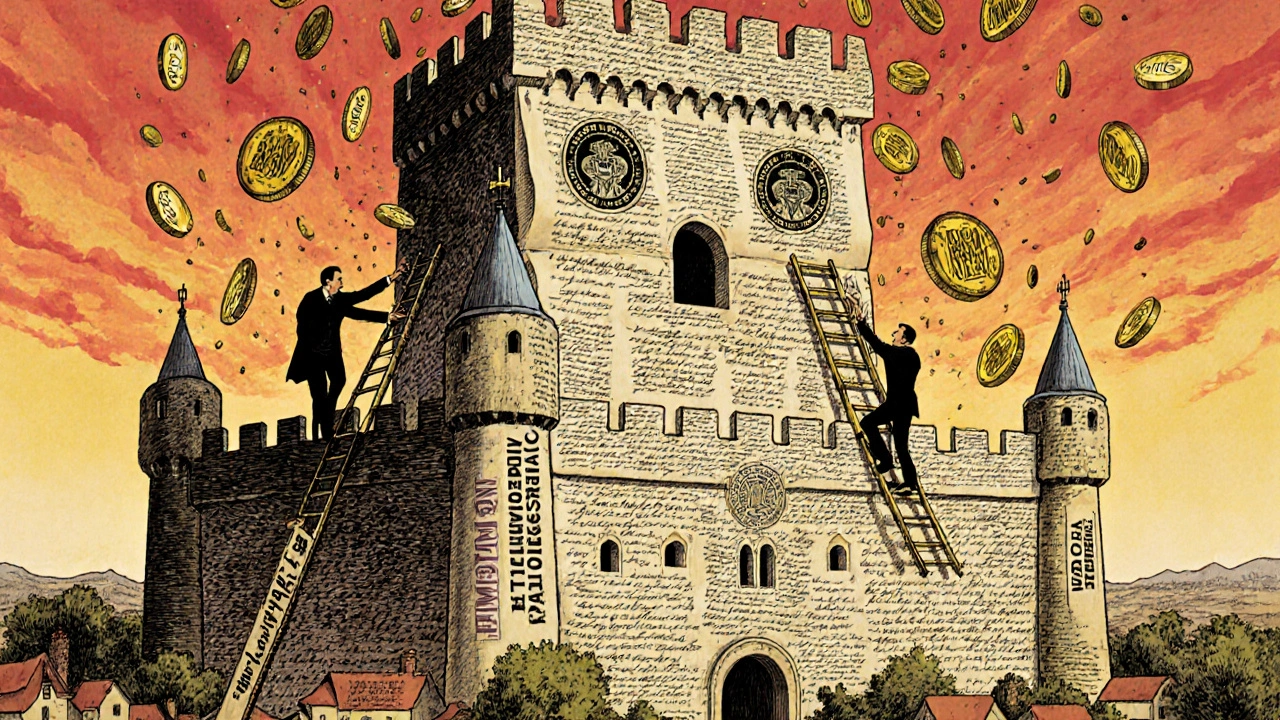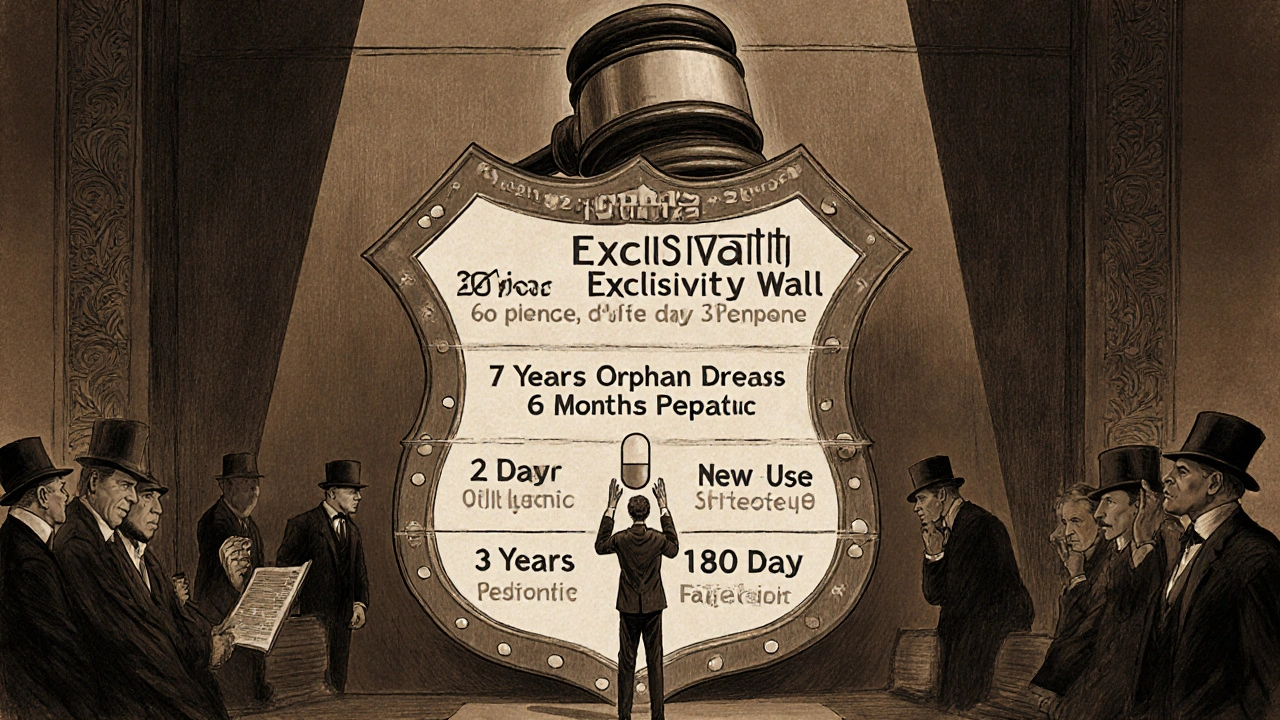Market Exclusivity Extensions: How Pharma Companies Extend Monopolies Beyond Patents
 Nov, 20 2025
Nov, 20 2025
Most people think when a drug’s patent expires, generics can jump in and slash prices. That’s not how it works anymore. In reality, many brand-name drugs stay on the market with no competition for 15 to 20 years-even after the original patent runs out. This isn’t magic. It’s a complex web of regulatory tools called market exclusivity extensions. These aren’t patents. They’re legal shields granted by health agencies like the FDA and EMA that block generics from entering, no matter what the patent says.
Why Patents Alone Don’t Protect Drugs Anymore
A standard patent lasts 20 years from the day it’s filed. But here’s the catch: drug development takes 10 to 12 years before it even hits the market. That means by the time a drug gets approved, you’ve already used up half your patent life. The original 20-year clock doesn’t match the real-world timeline of bringing a drug to patients. That’s why Congress created the Hatch-Waxman Act in 1984. It was meant to balance two things: giving companies enough time to profit from innovation, and letting generics in after a fair period. The original idea was simple: add up to five years to the patent to make up for FDA review delays, and cap total post-approval monopoly at 14 years. But that’s not what happened. Today, companies stack multiple layers of exclusivity on top of each other. A drug might get five years for being a new chemical, six months for pediatric studies, seven years as an orphan drug, and then three more years for a new use. Add in secondary patents covering pill coatings, dosing schedules, or delivery methods-and you’ve got a 20-year wall around the drug, even if the core patent is long gone.The Five Main Types of Market Exclusivity in the U.S.
The U.S. system has five key exclusivity types that work independently of patents. You don’t need a patent to get them. You just need to meet the FDA’s rules.- New Chemical Entity (NCE) exclusivity: Five years of protection for a drug with an active ingredient never seen before. No generics can even file for approval during this time.
- Orphan Drug exclusivity: Seven years for drugs treating conditions affecting fewer than 200,000 Americans. This one is huge. In 2022, 38% of all new drug approvals were for rare diseases. Companies are chasing this because it’s easier to get and lasts longer than most patents.
- New Clinical Investigation exclusivity: Three years for a new use of an existing drug. But here’s the trick: the FDA now demands real clinical proof that the new use is better than just prescribing the old drug off-label. That’s a higher bar than before.
- Pediatric exclusivity: Six months added to any existing exclusivity. To get it, companies must complete studies in children as requested by the FDA. It sounds altruistic, but it’s a strategic move. For a blockbuster drug, six extra months can mean over $1 billion in extra revenue.
- 180-day generic exclusivity: The first generic company to challenge a patent gets a six-month head start on other generics. This creates a race to the courthouse-and often delays other competitors even longer.
How the EU Does It Differently
Europe doesn’t use the same system. Instead of stacking exclusivities, they rely on the Supplemental Protection Certificate (SPC). It’s a single extension that can add up to five years to a patent, with a maximum total market protection of 15 years after approval. If a company does pediatric studies, they get an extra six months. The EU also has orphan drug exclusivity-but it’s 10 years, not seven. And if you complete pediatric studies, it jumps to 12 years. That’s longer than the U.S. But here’s the big difference: in the EU, you can’t stack multiple exclusivities like in the U.S. You get one primary protection, and that’s it. The U.S. system is more flexible-and more exploitable. Companies there have turned exclusivity into a game of Tetris, fitting every possible extension together to build a wall around their drug. In Europe, the rules are tighter. That’s why some U.S. companies move their orphan drug applications to the EU first-to lock in longer protection before bringing the drug home.
How Companies Game the System
It’s not just about playing by the rules. It’s about bending them. One tactic is called “product hopping.” A company releases a slightly changed version of a drug-maybe a new pill form, a different dose, or a digital tracker attached to the packaging-just before the patent expires. Then they push doctors and patients to switch. The original drug gets pulled from shelves. Generics can’t copy the new version because it’s protected by a new patent or exclusivity. Teva reported in 2022 that this tactic delayed generic entry for 17% of their target drugs. Then there’s the “patent thicket.” One drug, tazarotene, had 48 secondary patents covering everything from how it’s stored to how it’s applied. None of these patents were groundbreaking. But together, they created a legal maze. Generic makers had to fight dozens of lawsuits just to get started. Another trick? Delaying patent filings. Instead of filing a patent when the drug is first invented, companies wait until after Phase II trials. That way, the 20-year clock starts later-giving them more time to sell the drug before generics arrive. Bristol Myers Squibb and Novartis have used this strategy successfully. And then there’s the “evergreening” debate. Critics say these tactics aren’t about innovation-they’re about profit. A 2023 study in Health Affairs found that on average, generics are blocked for 9.2 years after the core patent expires. In 2000, that number was just 3.1 years.Who Benefits? Who Pays?
The winners are clear: pharmaceutical companies. In 2022, branded drugs made up 78% of U.S. pharmaceutical revenue, even though they accounted for only 10% of prescriptions. Why? Because exclusivity keeps prices high. A 2023 JAMA Health Forum study looked at four top-selling drugs: bimatoprost, celecoxib, glatiramer, and imatinib. When generics finally entered, the companies lost billions in sales. But because of extended exclusivity, the public paid an extra $3.5 billion over two years. That’s money that went to shareholders, not patients. The losers? Patients, insurers, and taxpayers. Medicare Part D spent $120 billion on brand-name drugs in 2022. Many of those were protected by exclusivity, not patents. For rare disease drugs, exclusivity is vital-it helps companies recoup costs for small markets. But for common drugs like diabetes or blood pressure meds? The system is broken.

Logan Romine
November 22, 2025 AT 05:11At this point, ‘innovation’ is just a legal loophole with a PowerPoint presentation.
Chris Vere
November 23, 2025 AT 09:40Pravin Manani
November 24, 2025 AT 17:12Mark Kahn
November 25, 2025 AT 12:26Leo Tamisch
November 26, 2025 AT 20:12Let me just say, if your ‘breakthrough’ drug is just a rebranded aspirin with a Bluetooth chip, you don’t deserve exclusivity-you deserve a TED Talk on how to monetize boredom.
And yes, I’m still mad about the $10K insulin.
Daisy L
November 27, 2025 AT 04:35These corporations are ROBBING OUR GRANDPARENTS blind!!!
They don’t care about patients-they care about their YACHTS!!!
And the FDA? They’re just the corporate lapdogs in lab coats!!!
WHY ISN’T CONGRESS DOING SOMETHING???
WE NEED A REVOLUTION!!!
🔥💸💀
Anne Nylander
November 28, 2025 AT 09:46people are skipping their meds because they cost too much and its not right
we need to fix this please
thank you for sharing this info it really helped me understand
Franck Emma
November 29, 2025 AT 18:04They knew.
They didn’t care.
Noah Fitzsimmons
November 30, 2025 AT 09:01Let me guess-you also think ‘pharmaceutical innovation’ isn’t just corporate theater wrapped in a white coat?
And you didn’t notice that 70% of orphan drugs are for conditions that affect 500 people total? That’s not medicine, that’s a tax write-off with a stethoscope.
Also, your dog probably has better healthcare than your neighbor.
Eliza Oakes
December 1, 2025 AT 22:16Everyone knows this. But here’s the twist: what if the system isn’t broken? What if it’s working EXACTLY as designed? To enrich shareholders while we cry into our $800 prescriptions? Maybe the real problem is we keep expecting morality from capitalism. 🤷♀️
Clifford Temple
December 2, 2025 AT 09:59Corra Hathaway
December 3, 2025 AT 07:10Yes, the system’s flawed-but look at all the progress! FTC actions, FDA rule changes, patient advocacy groups rising up!
Every time someone speaks up, it cracks the wall a little more 💪
Keep fighting, keep sharing, keep believing-we’re not powerless. You’re part of the change! 🌟❤️
Shawn Sakura
December 5, 2025 AT 00:36Paula Jane Butterfield
December 5, 2025 AT 23:32People cry in my office. Not because they’re weak-because they’re tired.
We need to stop calling this ‘innovation.’ It’s exploitation dressed in white coats.
Simone Wood
December 7, 2025 AT 16:50